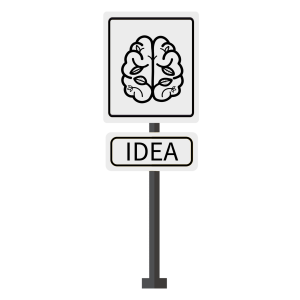Know it’s a Process: Ideas


Ideation means generating lots of ideas. Design thinkers use divergent and convergent thinking to come up with fresh solutions. After brainstorming to create many options and ideas (divergence), you must rank, sort, combine, and select the best (convergence) for further development.
Divergent Thinking
The ultimate goal of divergent thinking (also known as brainstorming) is to create new solutions for the problems you want to solve. Brainstorming encourages you to think expansively and without constraints. Brainstorming may often be thought of as unstructured, but it, in fact, is a focused activity that involves a lot of discipline. With careful preparation and clear rules, a brainstorming session can yield hundreds of fresh ideas. Insights become valuable when you can act on them as inspiring opportunities.
Defer judgement. There are no bad ideas at this point. There will be plenty of time to narrow them down later during the convergence phase.
Convergent Thinking
Convergence is fundamentally about arriving at conclusions by making connections or synthesizing data, ideas, and insights. Put differently, it’s about connecting the dots. To practice convergent thinking, here are some steps to follow:
- Pattern quest. Cluster related ideas. Spend a few minutes immediately after a brainstorming session, grouping together similar ideas into categories or buckets. Step back and identify important patterns that have emerged in your data. Try to find overlaps, themes, contradictions and tensions as they relate to each other.
- Grow an idea. Mix and match elements of ideas to create even better ones. By remixing and combining ideas, whether good or bad, feasible or infeasible, you will generate new ones.
- Narrow the set. So far, you have (hopefully) been developing your idea without giving much thought to the constraints you may face while attempting to realize it. It makes sense to now do a reality check: look at what’s most important about your idea and find ways to evolve and develop it further. Now is the time for evaluation. Decide what makes some of your ideas more achievable than others. Look at all of the ideas you have generated, then decide which you want to try to build and test first.
- List constraints. Make a list of all the challenges and barriers you are facing with your idea. What are you missing? Who would oppose the idea? What will be most difficult to overcome? Brainstorm how you might address some of these challenges.
- Archive ideas. Let go of ideas that feel too difficult to create or that you are not excited about. Keep your Post-its and notes so you can revisit them later.
Attribution
“Chapter 03: Ideate” from Design Thinking Copyright © by Sidneyeve Matrix is licensed under a Creative Commons Attribution-NonCommercial-ShareAlike 4.0 International License, except where otherwise noted.

